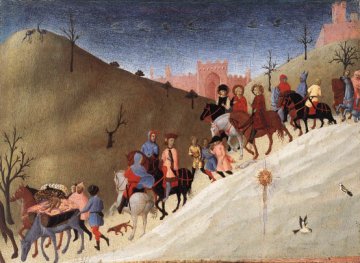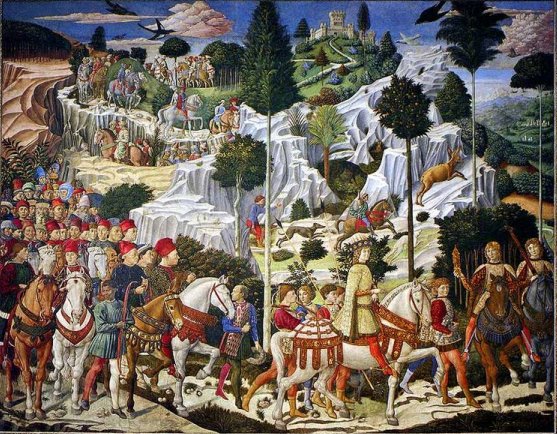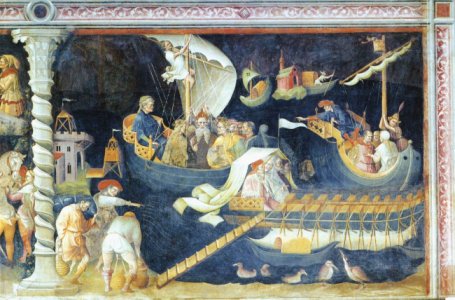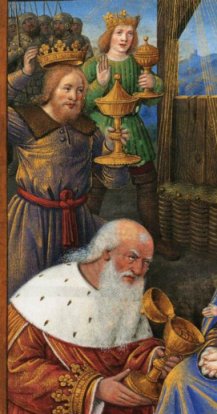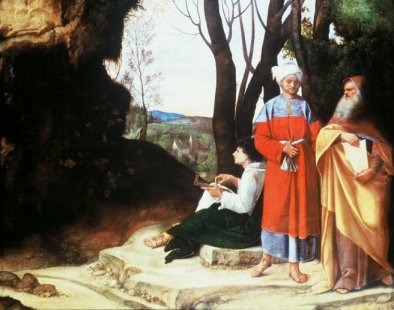|
|
|
|
|
|
|
|
|
|
|
|
|
Return of the Magi A very rare theme - in fact, this image by Giovanni da Modena is only one I have come across. The Magi are attempting to slip off home inconspicuously so that Herod doesn't notice. According to Arnobius (died c.330 and quoted by the 12th century Anselm of Laon), When Herod found out, he ordered the destruction of all shipping in the harbour of Tarsus in his rage. |
|
|
|
|
|
The gifts
Gold is said to represent Kingship, which is straightforward enough. Caspar, the most frequent gold-bearer, is sometimes described as 'King of Tarsus, land of the Merchants' so he's the one with the money. Frankincense, a product of Arabia, is slightly more complicated. It was burnt in the Jewish temples, and its pure fragrance is said to represent divinity: And the LORD said unto Moses, Take unto thee sweet spices, stacte, and onycha, and galbanum; these sweet spices with pure frankincense: of each shall there be a like weight: And thou shalt make it a perfume, a confection after the art of the apothecary, tempered together, pure and holy: And thou shalt beat some of it very small, and put of it before the testimony in the tabernacle of the congregation, where I will meet with thee: it shall be unto you most holy. (Exodus Ch. 30 v 34 - 30) Myrrh comes from Ethiopia, so is appropriate for the African magus. It is associated with death - Egyptians used it as part of the embalming process These varied gifts can be interpreted in many ways. Perhaps we had best leave it at Origen's succinct comment: 'gold, as to a king; myrrh, as to one who was mortal; and incense, as to a God'. ( from Contra Celsum.) The Catholic Encyclopaedia provides a sensible warning note: 'The purpose of the gold is clear; the Child was poor. We do not know the purpose of the other gifts. The Magi probably meant no symbolism. The Fathers have found manifold and multiform symbolic meanings in the three gifts; it is not clear that any of these meanings are inspired.' |
|
|
|
|
|
Frank de Stefano, on his excellent blog mainly
devoted to Giorgione (http://giorgionetempesta.blogspot.co.uk/)
Discusses Giorgione's painting generally know as The Three
Philosophers. His conclusions are intriguing. Others have
suggested that these figures may represent the Magi. Frank goes
further: ' . . . I believe that there is one more piece of evidence that so far has eluded scholars but will help to make the case for the Magi. The most obvious feature in the painting is the brilliant colour of the costumes. In the ancient legend the gifts of the Magi were gold, frankincense, and myrrh. In the medieval legend, the oldest of the Magi was the bearer of the gold; the middle aged man carried the myrrh; and the youngest brought the frankincense. The golden garment of the oldest man needs no explanation. In my encyclopaedia the colour of myrrh is a dark red, while the colour of frankincense can be white or green, the colours of the sitting young man.' |
|
|
|
|
|
|
|

